In Craig Larman's book Applying UML and Patterns: An Introduction to Object-Oriented Analysis and Design and Iterative Development (3rd Edition), a use case is converted to a System Sequence Diagram (SSD) which contains system operations. It's a way of doing high-level design first, that's easily traceable to the requirements (use case), and later refining it by detailing the system operations at the domain level via OO design principles.
I'm trying to understand this methodology using RESTful services. The trouble spots seem to be with resources and the stateless operations.
Here's a sample from the book, an SSD with four system operations:

An SSD is also an abstraction of the presentation layer (on the left) and the domain layer (on the right). The domain layer might also include the application and or business logic.
In Larman's approach, a system operation (e.g., makeNewSale()) should be handled by a GRASP Controller which is a domain non-presentation-layer object that handles the system operation.
Now, let's say we're trying to use RESTful services in this approach:
- The Uniform Interface constraint of REST is part of the presentation layer. For example, one can configure the route that a POST operation on a resource takes, allowing it to eventually call some operation of an object in the Domain layer. This Byte Rot blog by Aliostad explains very well the details of traditional layer architectures and REST.
- In Larman's example, the Cashier clicks somewhere in the GUI to invoke a
http://...com/sales - POST requestand eventually a GRASP Controller receivesmakeNewSale(). The REST parthttp://...com/sales - POST requestcreates a new resource for the sale e.g.,001and alsomakeNewSale()is sent to a GRASP controller object.
- In Larman's example, the Cashier clicks somewhere in the GUI to invoke a
- Session Controllers (mentioned in the GRASP Controller pattern) don't exist on the System, since REST operations are stateless on the server. This implies that system operations might actually need more arguments to pass state information to the server, and that isn't obvious from the use case. For example,
makeNewSale()probably needs to receive and process an authentication token as an argument, since:Systemhas no session information. I found a related question and answers here at RESTful Authentication
So, assuming my understanding up to now is right, my questions are:
Does the Uniform Interface constraint of REST respect loose coupling of presentation/domain layer separation? At first, it seems to be a detail of the presentation layer (like an
actionPerformed()method in Java Swing). But the part that bothers me is thathttp://...com/salesties right into aSale(which is a domain) object.
Another way of putting it: by creating REST resources and REST verbs accessing them via a Uniform Interface, isn't application/business logic being put into to the presentation layer? Larman's SSD approach is about layers and he explicitly states that application logic should not go in the presentation layer. For example, a POST tohttp://...com/salescreates a newsales/001resource and also sendsmakeNewSale(). The first part seems like business logic. The fact that my REST resource names follow many of my Domain object names seems like my Presentation layer is (more) coupled to my Domain layer, than if I were using Swing and only calledmakeNewSale()from anactionPerformed()on aJButton.Larman's SSD concept is oriented towards the RCP model (with state in the server), but can an SSD be made to easily jibe with a REST philosophy? For example,
endSale()exists to break the system out of a loop ofenterItem()calls. Later in the book, Larman even presents a state diagram about this:

I read about How to manage state in REST and it seems one has to take care with passing state on each system operation if needed (as in the authentication token example above), or the "state" is actually encapsulated in the resources. I thought about it, and with REST,endSale()could probably be removed entirely.
I used a concrete example here, so that the answers can also be concrete.